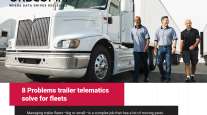Class 8 Fleet Grows 2.8% in 4Q to Highest Level in Five Years
This story appears in the March 3 print edition of Transport Topics.
The U.S. heavy-duty truck fleet grew 2.8% in the fourth quarter from a year ago to the largest size in five years, as carriers purchased mainly replacement equipment while gradually expanding their operations, according to a new report.
The total number of registered Class 8 vehicles at year-end stood at 3.65 million, up from 3.54 million at the end of 2012, according to the latest Polk quarterly commercial vehicle report from IHS Automotive.
Despite that growth, the trucking industry remains entrenched mostly in a replacement-driven cycle with only modest fleet expansion, said Gary Meteer, director of global commercial vehicle products at IHS.
Fleets still haven’t seen a robust enough increase in freight demand to “jump in with both feet and really put more trucks on the ground,” Meteer said.
The increase in the total vehicle count during the quarter is due in part to the timing of replacement purchases and the subsequent sale of trade-in vehicles, Meteer said. It takes a while for dealers to sell those used trucks before they’re once again placed in operation.
Meanwhile, first-time registrations of new heavy-duty trucks increased 1.6% during the quarter to 49,262, up from 48,510 in the fourth quarter of 2012, according to the data released Feb. 21.
For the full year, though, registrations fell 4.5% to 189,300 from 198,300 in 2012, the Polk report said.
The data showed that new registrations fell 11.1% last year among large fleets operating more than 500 trucks but climbed 13.6% among small fleets and owner-operators with one to 25 vehicles.
Meteer said that trend may reflect an increase in large fleets subcontracting with smaller truckers to handle additional business.
He predicted 2014 will bring “minimal” expansion in the overall Class 8 truck fleet.
Truck buyers are still focused primarily on replacing old equipment, but there is some “moderate” growth and “a lot of quoting activity,” said Kurt Jorgensen, co-owner of JX Enterprises, a Peterbilt and Volvo dealer group headquartered in Hartland, Wis.
“I don’t think anyone’s really bullish about growth right now,” he said. “They have plans in place to grow, but I don’t see a lot of people executing those plans.”
Jorgensen suggested that some fleets may have delayed their decisions while contending with the harsh winter weather.
He expressed optimism that business will improve this year as housing and construction continue to trend in the right direction.
Polk reported that new registrations declined last year in all U.S. regions except for the West, where they increased 6.8% from 2012 levels.
Two fleets operating in the region attributed the increase to new California Air Resources Board regulations.
Andrus Transportation Services Inc., a regional truckload hauler based in St. George, Utah, is working to reduce the length of its truck replacement cycle, in part because of those requirements, said Lynn Shrum, the company’s vice president of safety and human resources.
Another factor is the desire to boost driver satisfaction, she said.
“Things like built-in Bluetooth and bunk heaters add to their quality of life while they’re out driving,” she said.
Although most of Andrus Transportation’s new trucks last year were replacement purchases, the company did increase the size of its 300-tractor fleet by about 2%, Shrum said.
The company saw a “slight” pickup in freight demand in 2013 but “not so significant that we would go out tomorrow and increase our fleet size by 10%,” she said.
On the other hand, Faulkner Trucking Inc., in Tulare, Calif., didn’t add to its fleet of 50 trucks last year.
“We have replaced trucks, but we haven’t added trucks,” said Ron Faulkner, owner and president of the regional truckload carrier.
He said his company has spent almost $1.8 million in the past three years to comply with CARB’s requirements, both through new truck purchases and retrofitting existing units with diesel particulate filters.
But regulation isn’t the only reason Faulkner has turned to newer trucks.
He said his company’s new 2014 model-year tractors equipped with automated manual transmissions are getting as much as 2 miles per gallon better fuel efficiency than older units.
“I always used to buy used equipment from the big fleets, usually something that’s 2-3 years old. Now we’ve started buying new for the fuel economy,” Faulkner said.
He predicted that freight capacity will tighten later this year, when some older trucks become noncompliant after CARB’s extended July 1 deadline.
The Polk report also included registration data for natural-gas engines. During 2013, a total of 4,330 compressed natural gas engines were installed at the factory in Classes 3-8 vehicles, up 5.8% from 2012, the report said.




